Mansfield St AugustineFeatures and Fittings
Altar
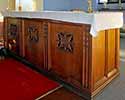 The altar is set forward of the east wall. It has a three-panel front with the centre of each panel being decorated with a pierced square section. The four uprights surrounding the panels also have carving. It is finished with a mahogany stain. The altar is set forward of the east wall. It has a three-panel front with the centre of each panel being decorated with a pierced square section. The four uprights surrounding the panels also have carving. It is finished with a mahogany stain.
Communion Rail
Set on the front edge of the Sanctuary is a stained wooden Communion Rail with both the top edges chamfered. It is supported by a plain square section with black painted metal stanchions.
Lectern
 Located forward and to the right of the altar is the lectern. It has a cross-shaped base supporting a plain central pedestal with four curved brackets rising from the base of the pedestal. The book rest has a traditional sloping top with carving decoration each end and at the front. Located forward and to the right of the altar is the lectern. It has a cross-shaped base supporting a plain central pedestal with four curved brackets rising from the base of the pedestal. The book rest has a traditional sloping top with carving decoration each end and at the front.
The inscription on the base reads:
TO THE GREATER
GLORY OF GOD
AND IN LOVING
MEMORY OF
FLYING OFFICER
LEONARD WHETTON
KILLED IN ACTION
25 AUG 1944 R.I.P. |
Flying Officer Leonard Whetton's Lancaster bomber (626 Squadron, Royal Air Force Volunteer Reserve) was shot down during a raid on the Opel motor factory at Rüsselsreim on 25 August 1944. He was the son of William and Elizabeth Whetton and husband of Marjorie Whetton, of Mansfield. Whetton was born in Sutton-in-Ashfield, educated at Queen Elizabeth’s Grammar School, Mansfield, and was in a furnishing business at Shirebrook before joining the R.A.F. in 1940. He is buried at the Durnbach War Cemetery south of Munich.
Reading desk
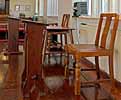 Close by the lectern is a small plain reading desk of light stained oak. Close by the lectern is a small plain reading desk of light stained oak.
It was a memorial gift to the church and has a small inscribed brass plate:
Given to St Augustine’s Church
by her family and friends
in loving memory of
Ena Carter
Died 24 June 1981 |
Font
 The final piece of furniture within the sanctuary is the font. It is located on the south side. It is of plain oak with a low, square base with slightly chamfered sides and a square central pillar. The squared top that houses the bowl also has a slightly chamfered side. It is completed by a small upstanding Maltese style cross. The baptism bowl is made of copper. This piece was also donated as a memorial gift, with the inscription: The final piece of furniture within the sanctuary is the font. It is located on the south side. It is of plain oak with a low, square base with slightly chamfered sides and a square central pillar. The squared top that houses the bowl also has a slightly chamfered side. It is completed by a small upstanding Maltese style cross. The baptism bowl is made of copper. This piece was also donated as a memorial gift, with the inscription:
TO THE GLORY OF GOD
AND IN LOVING MEMORY OF
SIDNEY JAMES FOWLER
THIS FONT WAS PRESENTED TO
ST. AUGUSTINE'S
BY
HIS FAMILY
1971 |
Two reading desks
Also on the south side of the sanctuary are two more reading desks, one each side of the window. One has an inscription:
In loving memory of Charles Alfred and
Mary Jane Barnes
Presented by their family |
Processional cross
 The brass processional cross mounted on the wall of the sanctuary has the following inscription: The brass processional cross mounted on the wall of the sanctuary has the following inscription:
SARAH HEAP
A FAITHFUL WORSHIPPER
IN THIS CHURCH
9. 6. 50. |
Pews
 Pews Pews |
 Book rest Book rest |
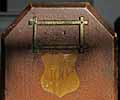 Card holder Card holder |
 Label Label |
The pews at present filling St. Augustine’s Church predate it by many years. They were originally installed in St. Ann’s Church in Nottingham when it opened in 1864. Others may date from an extension of that church in 1871. It was closed and demolished in 1971, at which time they were transferred to St. Augustine’s.
The pews are constructed of pine timber darkened by the application of stain over the years. On the north side of the church there are eight and a half pews, and on the south eight pews. A unique feature of these pews is the survival of the word ‘FREE’ stencilled on the book rest near the entrance to some of the pews, plus the small ornate brass card holders fixed to the end of some pews. This enabled these pews to clearly indicate who was allowed to sit where. Also on some of the pews on the book rest there are labels, well-worn and varnished over:
ST. ANN'S CHURCH.
In order that the work of God may be properly carried out in
its church and the solemn duty maintained,
the clergy and churchwardens and sidesmen and the congre-
gation continue contributing liberally to the offertory. |
Cupboard
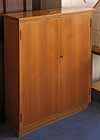 A wooden cupboard near the organ with a plaque that reads: A wooden cupboard near the organ with a plaque that reads:
DONATED TO ST. AUGUSTINES
IN LOVING MEMORY OF
ELLEN & THOMAS SHARMAN
1974 |
Table
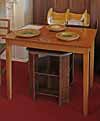 Wooden table near the organ with an plaque that states: Wooden table near the organ with an plaque that states:
TO THE GLORY OF GOD
IN MEMORY OF
ELIZABETH WALTON
DIED NOV. 15TH 1971 |
| 


















